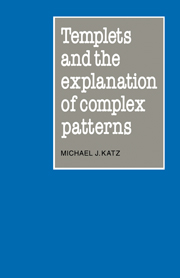Book contents
- Frontmatter
- Contents
- Prologue
- Introduction
- 1 Scientific abstractions
- 2 The nature of explanation
- 3 Configurational explanations
- 4 Templeting
- 5 Self-assembly
- 6 Rules for configurational explanations
- 7 Simple, complex and random
- 8 Reductionism
- Appendix: A pattern theoretic formalization
- Quotation index
- Subject index
- Frontmatter
- Contents
- Prologue
- Introduction
- 1 Scientific abstractions
- 2 The nature of explanation
- 3 Configurational explanations
- 4 Templeting
- 5 Self-assembly
- 6 Rules for configurational explanations
- 7 Simple, complex and random
- 8 Reductionism
- Appendix: A pattern theoretic formalization
- Quotation index
- Subject index
Summary
Where am I? Metaphysics says
No question can be asked unless
It has an answer, so I can
Assume this maze has got a plan.
(W.H. Auden ‘The labyrinth’.)How can a scientist make sense of very complex systems? What logical abstractions can he use to dissect phenomena that cannot easily be reduced to simpler parts? Like all scientists, researchers faced with complex systems wish to construct rigorous scientific explanations; yet the particular phenomena that they have at hand are often forbiddingly tangled. Some complex phenomena are so heterogeneous that they appear almost random; but, surprisingly, they differ from the truly random in that they are faithfully reproducible. ‘Random’ means more than extremely heterogeneous – it also means unpredictable.
In most methods for analyzing random phenomena, these two ideas – heterogeneity and unpredictability – are inextricably intertwined. For this reason, the standard stochastic tools for explaining random phenomena often cannot be effectively applied to heterogeneous yet highly stereotyped (predictable) phenomena. The realm of the very heterogeneous is not the usual realm of classical physics. But, the task of scientifically explaining heterogeneous phenomena is the task of most other disciplines. It represents the daily challenges of biology, psychology, sociology, economics, meteorology, epidemiology, metallurgy and geology. Theoreticians in each of these disciplines continually face inescapable, and at times irreducible, heterogeneity. And, irreducible heterogeneity is tantamount to complexity.
This book presents the beginnings of one epistemological approach to the natural science of complex systems.
- Type
- Chapter
- Information
- Templets and the Explanation of Complex Patterns , pp. 1 - 4Publisher: Cambridge University PressPrint publication year: 1986
- 1
- Cited by



